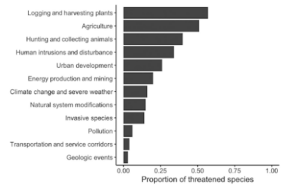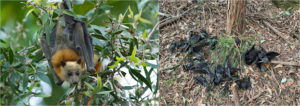How climate change is threatening bats
By Yann Gager
Manmade climate change is shifting natural habitats faster than ever—from global rises in temperature to increases in the frequency of extreme climate events. This has resulted in changes to the landscape that not all species can adapt to, with bats being no exception. According to a study published last year in Annals of the New York Academy of Sciences, climate change constitutes one of the major menaces to the survival of many bat species. Other major threats included logging and harvesting plants, agriculture, hunting, and energy production and mining (Fig. 1). The list of threats was determined by analyzing 180 bat species that are recognized by the IUCN Red List in 2018 as Critically Endangered, Endangered, or Vulnerable.

|
Figure 1. Ranking of major threat types for threatened bat species, based on IUCN Red List (2018) assessments. A total of 170 species (94% of assessed threatened species) had at least one threat type listed. Source: Frick et al. (2019).
|
Since the beginning of the Industrial Revolution, heat-trapping gases released by human activity have directly increased the frequency, duration and intensity of temperature extremes, storms, and droughts. Extreme temperature events have already threatened multiple bat species. For instance, temperatures of over 42°C (107.6°F) in Australia led to mass die-offs of flying foxes due to physiological stress. In just one day in the summer of 2014, over 45,500 flying foxes belonging to three species (Pteropus alecto, P. poliocephalus and P. scapulatus) died from such an event. Higher mortality was observed in adult females and dependent pups, resulting in long-term negative impacts on species persistence due to reduction of reproductive potential in the population. In response to increasing temperatures linked to climate change, some bat species have also expanded their geographical range. A well-known example is Pipistrellus kuhlii, which increased its species distribution range by 394% in the last four decades.
 |
| Figure 2. Grey-headed flying foxes (Pteropus poliocephalus) in Brisbane, Australia (left). This species is extremely vulnerable to heatwaves, resulting in mass die-offs (right). Photos by Andrew Mercer and Sarah Elizabeth Curran, respectively. |
According to consensus projections, tropical cyclones will decrease in number but increase in their maximum intensity and rainfall. Different species of flying foxes will be negatively impacted by cyclonic storms, with significant declines previously observed in various archipelagic systems, such as Guam, the Marianas, Rodrigues, Samoa, the Solomon Islands, and Tonga. Individuals are not only killed by storms but also starved after storms have reduced the level of food resources available in the landscape. This leads to bats foraging in suboptimal spaces near villages or closer to the ground, making it possible for humans and pets to kill them. Crashes in flying fox populations are catastrophic for the forest ecosystems on islands considering that the bats cease to function as seed dispersers long before they become rare.
An indirect threat from climate change to bats comes from the need for renewable energy sources leading to the expansion of industrialized wind farms. Wind turbines can have a significant negative impact on both bird and bat populations if they are built at the wrong site, potentially disproportionately negatively impacting migratory species that are attracted to the turbines. This situation is a typical green-green dilemma, where conflict between the needs of renewable energy to reduce carbon emissions are at odds with biodiversity conservation. Turning off the wind turbines during periods of low wind speeds as well as during migration season are proven mitigation strategies to reduce casualties. Furthermore, recent research in Texas shows the efficacy of ultrasonic acoustic deterrents to reduce bat fatalities for some species. Understanding the numerous causes and consequences of bat fatalities at wind farms is critical to minimizing the impact of wind energy on bat populations.
The increase in temperature extremes, storms, and droughts predicted by current climate models will increase additional pressure on species already threatened as well as species not yet threatened. Furthermore, 227 species are classified as Data Deficient by the 2018 IUCN Red List—approximately 16% of all bat species. Data Deficient species do not have sufficient information for a proper assessment of conservation status to be made and may often slip through the cracks when determining conservation priorities. These species should be the focus of research to get a more accurate and detailed picture of the threats faced by all bats from climate change.
It is abundantly clear that climate change has already made an impact on bats, and consequently, whole ecosystems dependent on bats, such as island forests, are being affected as well. Fighting climate change by decarbonizing human activities is an endeavor that bat researchers and enthusiasts alike can contribute to in order to ensure the continued persistence of bat species and natural spaces into the future.

